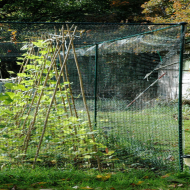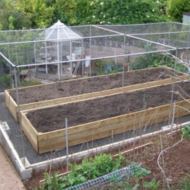We use cookies to make your experience better. To comply with the new e-Privacy directive, we need to ask for your consent to set the cookies. Learn more.
DIY Plant Cages For Your Garden or Allotment
- Admin
- WM James Gardening Blog
- 3 Aug 2022
-
29views

An easy way to protect your plants from pests and bad weather are plant cages, fruit or vegetable cages. At William James, we offer a range of solutions to protect your garden.
If you're looking for an easy way to protect your plants from pests and bad weather, you should try using plant cages.
Plant cages are simple structures made of metal or wire that can be used to support plants and protect them from the elements. They're a great way to keep your plants healthy and safe, and they're also very affordable.
At William James, we offer pre-made plant cages, but because we realise your plants, fruit, or vegetables may require a custom size plant cage, we also sell a range of made-to-order frames, cages and netting.
If you're looking to simply repair an existing plant cage, or would like to extend it, then we stock accessories such as footplates, door frames, netting clips and sockets so you can be confident your garden or allotment will be free of pests and wildlife.
What are plant cages and why do you need them
A plant cage can be used for many different plants and not just for growing fruit and vegetables. They are excellent for supporting delicate flowers, shrubs and climbers and will prevent them from falling over. Plant cages are also effective at keeping birds and pests, such as rabbits, away from your plants.
The different types of plant cages available
Plant cages come in various designs, materials and sizes and can also be used in combination with each other to create a bespoke design.
Tomato Cages
Tomato cages give your plants a sturdy base to grow and mature. These cages are easily assembled and come with strong construction to keep your tomatoes standing tall and sturdy.

Polytunnels
Polytunnels are large metal or plastic structures that cover an area of ground. They are often used to extend the growing season by protecting plants against bad weather and frost. Polytunnels can be used to grow a wide range of vegetables and other plants.
Arches
Arches are useful for supporting plants that aren't suitable for being grown in containers, such as larger herbs. Arches can be placed in the middle of a bed or border to add interest and support plants growing on either side.
Trellis
Trellis can be used to support climbing plants, such as tomatoes, cucumbers or runner beans. Trellises can be made from a variety of materials, such as wood, metal or netting.
Fruit Cages
Fruit cages are wire cages that are useful for growing larger plants such as melons, squash, pumpkins, peppers and tomatoes.

How to make your own DIY plant cages
Plant cages are one of the easiest ways to help your plants thrive. For the best results, you should start the construction of your plant cages around the time that you plant your seedlings. This will allow your plants to grow up inside the cage and give them a greater chance of survival.
- Create your cage frame out of wood or metal
- Curl mesh into shape. Typically for plant cages, this is a cylinder.
- Secure the mesh into place with wire or zip ties.
- Install your cage over your plant.
- If using, secure netting over your cage to protect your plant from pests.
6 Tips for using plant cages in your garden or allotment
Plant cages are great for protecting plants that have shallow roots, like lettuce, carrots, and other vegetables that need lots of water. Plant cages are also great for keeping animals out of your plants and are particularly useful if you have a small garden or growing space. Read on for our top plat cage tips.
Layout
When you're planning your garden, you should consider how you're going to use plant cages. This can help you decide where to place them and how many you need. When assessing your garden layout, try to make sure there's enough space between them, so your plants have room to grow.
Type Of Plants
There are many types of plants you can use in plant cages; some of the most popular types include tomatoes, peppers, and brassicas.
Netting
You should choose the type of netting that you want to use based on what you're growing. If you're growing smaller plants, you'll probably want to use finer netting. If you're growing larger plants, you'll find that using thicker netting will be a better option.
Securing Your Cage
When securing your plant cage, it's important to make sure that you choose a material that will securely hold the cage in place and will not rust, rot, or damage your garden. Sockets and clips are a simple way to help secure parts of your cage together.
Maintenance
You should check your plant cage regularly to make sure that it's secure and that there aren't any holes or tears. You may need to adjust the netting or tighten any bolts as they may become loose after a while. You may also need to repair parts of your plant cage if they get damaged.
Budget
The price of plant cages can vary depending on the materials you want to use. Additionally, your budget will also need to cover how many plant cages you will be building and what type.

Final Thoughts
When you're growing plants that produce a lot of fruit or vegetables or have shallow roots, you can use plant cages to help you maximise your harvest by giving you a defined space to grow. Plant cages are a great way to protect your plants, and they can be used in a variety of different ways. They're also very affordable, so you don't have to break the bank to buy them.
FAQs
What plants do you need cages for?
You can use cages for a variety of plants. However, they are most commonly used for vegetables, berries, and fruits, such as tomatoes, runner beans, peas, plums, strawberries and raspberries.
Why do you need a fruit cage?
Plants that bear fruit need cages to protect them from pests such as insects and animals.
Do you cage cucumber plants?
Cucumbers are vining plants, and providing a cage with stakes or a trellis is the best way to keep them healthy.
When should I put cages on my tomato plants?
Once you've planted your tomato plants, you should install the cage as early as possible to allow the roots to grow uninterrupted by pests like insects and animals. Installing after the plant has matured can damage it.
Do raspberries need cages?
Cages help keep raspberry plants off the ground, which avoids overcrowding and allows for easy harvesting. Additionally, cages protect your raspberries from pests.
Related Posts














